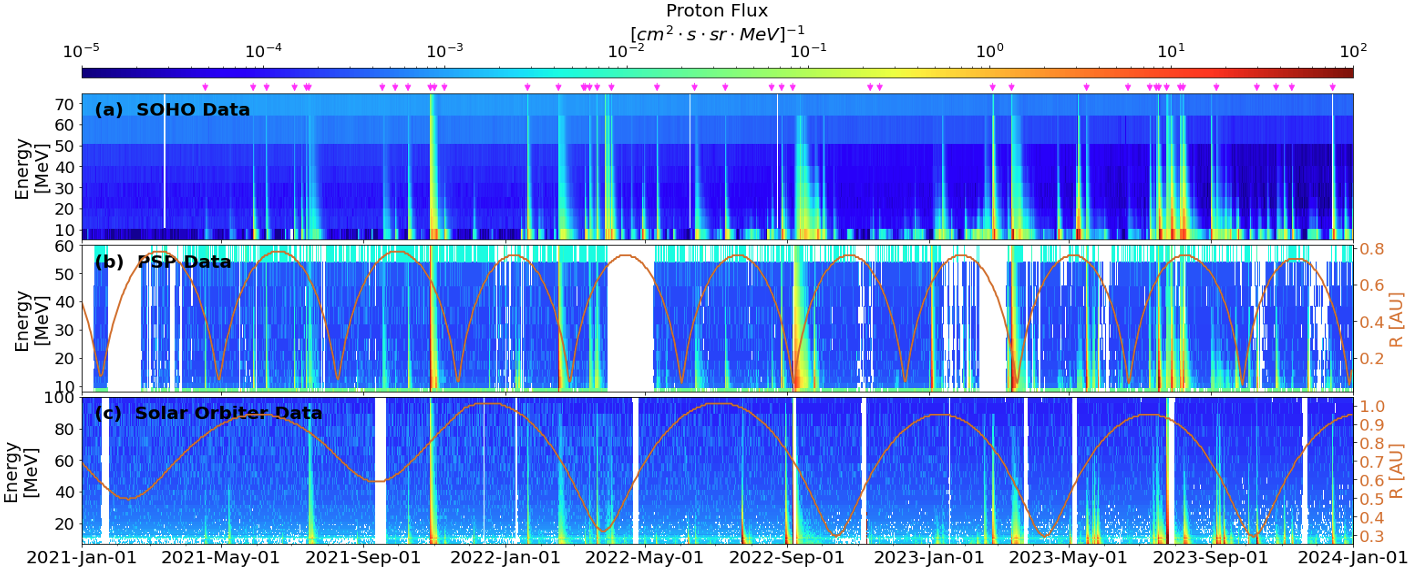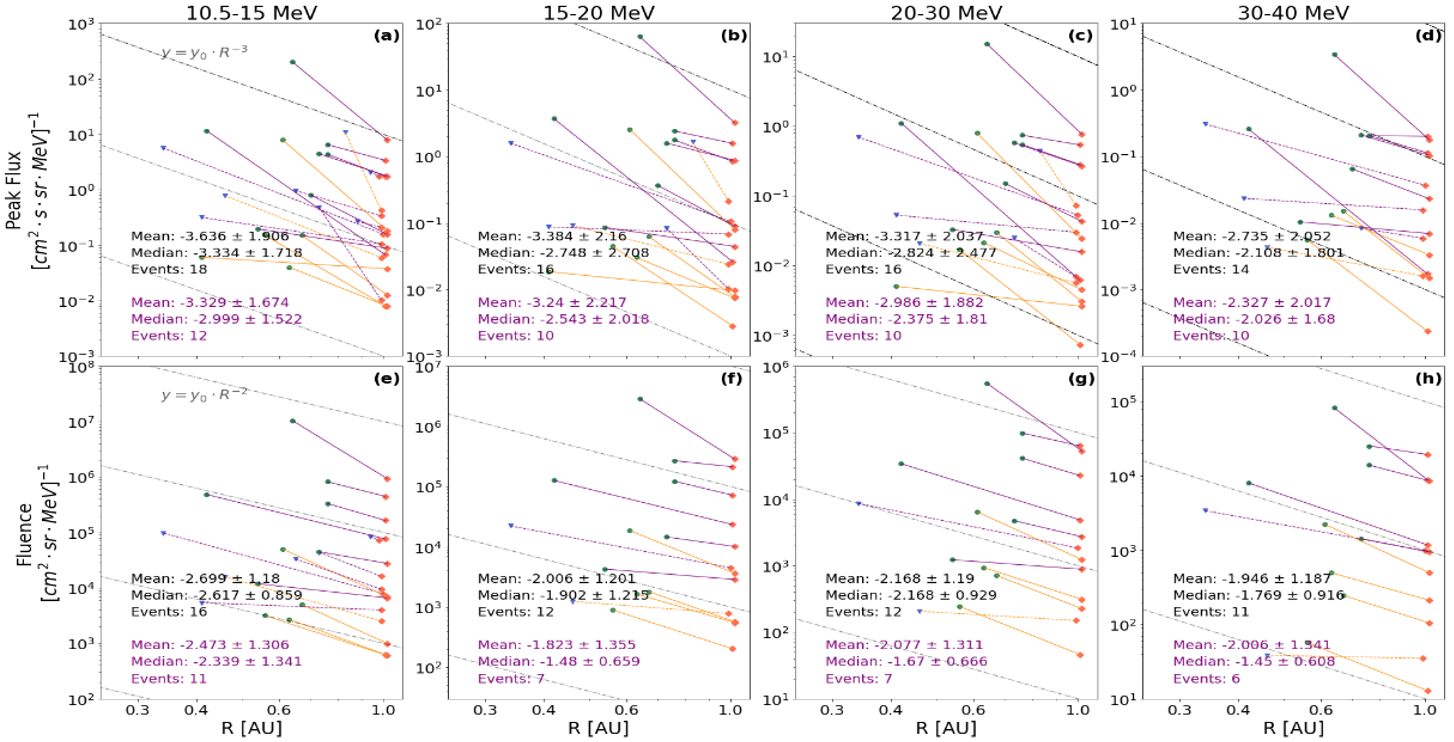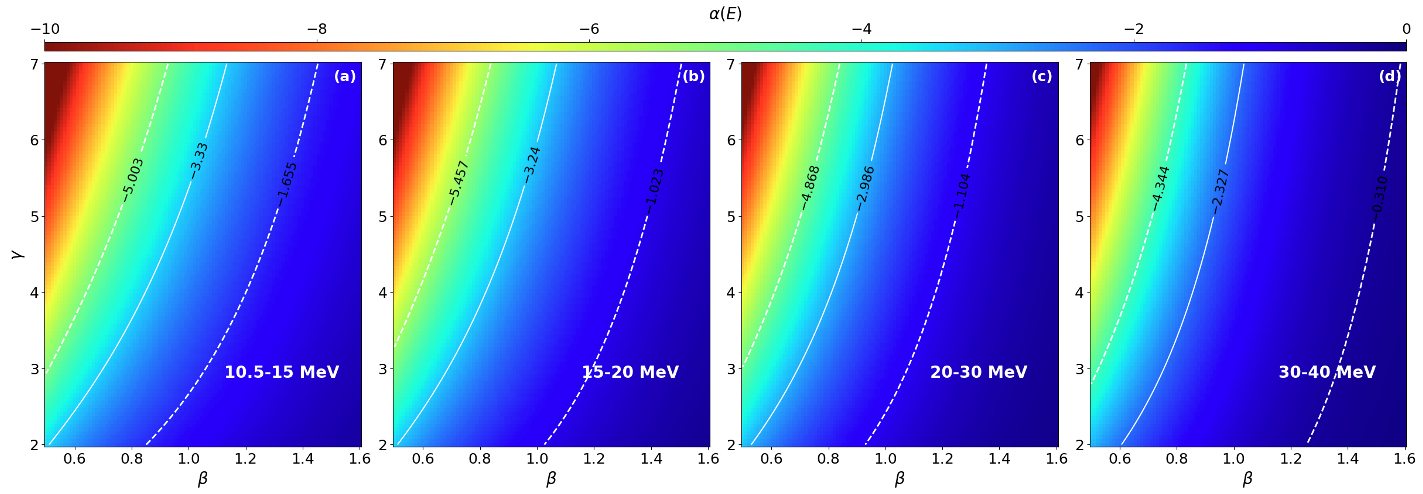Science Nugget: Radial dependence of solar energetic particle peak fluxes and fluences - Solar Orbiter
Radial dependence of solar energetic particle peak fluxes and fluences
(Solar Orbiter Nugget #55 by Yihang Cao1, Yubao Wang1, Jingnan Guo1,2)
1. Introduction
As the core energy source of the solar system, the Sun continuously supplies energy to interplanetary space through persistent radiative and particle emissions. At the microscopic level, this energy propagates outward in the form of electromagnetic waves and particle streams of varying energies. Among these, Solar Energetic Particles (SEPs), originating from solar eruptions, may not only cause substantial interference with electronic equipment but also pose potential hazards for human space science endeavors due to their ionization process [1, 2]. Therefore, better understanding their distribution characteristics in the highly dynamic and complex interplanetary space, such as how their flux decay as they travel further from the Sun to the heliosphere, not only helps reveal the propagation mechanisms of SEPs but also provides theoretical support for space weather prediction and radiation mitigation strategies, especially for locations where SEP observations are lacking while forecasting is necessary.
Within the ecliptic plane, the propagation of SEP events can be simplified into two primary processes: outward radial propagation and longitudinal propagation to a wider coverage of longitudes (in comparison to the source). Separating these two processes for each individual event is rather challenging. Fortunately, studying the longitudinal distribution of SEP events has become straightforward with the data from the STEREO (Solar TErrestrial RElations Observatory launched in late 2006, see STEREO website) twin satellites, which were both positioned at approximately 1 AU from the Sun. Scientists discovered that the flux of SEP events typically exhibit a Gaussian distribution in longitude at 1 au [3, 4, 5]. However, due to the lack of data collected at solar distances other than 1 AU, it has been challenging to study the radial gradient of SEPs, although the theory of radial diffusion for SEP events was proposed decades ago [6]. A couple of studies had analyzed some specific SEP events observed by satellites at close longitudes but different radial positions [7, 8], while other studies explored the radial dependence using simulations of particle acceleration and diffusion processes [9].
In the last few years, with the successful launch of Solar Orbiter and Parker Solar Probe (PSP), we have accumulated many SEP events allowing detailed analysis of the radial distribution of SEP flux and its dependence on proton energies, offering new perspectives and theoretical references for SEP propagation processes. A couple of recent studies using the Solar Orbiter electron measurements have investigated the radial dependence of peak flux, anisotropy, and other related phenomena of solar energetic electrons in interplanetary space [10, 11]. Our work focuses on the distribution of energetic protons.
2. Results (Statistical data obtained and SEP event selection)
This statistical analysis utilizes SEP data observed by three spacecraft: Solar and Heliospheric Observatory (SOHO), PSP, and Solar Orbiter. During the study period from 2021-01-01 to 2024-01-01, the SOHO spacecraft operated within a radial distance range of 0.97 to 1.01 AU from the Sun, while PSP and Solar Orbiter covered radial distances of 0.05 to 0.78 AU and 0.29 to 1.01 AU, respectively (see Figure 1 for overview of spacecraft solar distances and particle fluxes in 3 years).

Figure 1. An overview of multi-spacecraft SEP observations from January 1, 2021, to January 1, 2024. The pink arrows at the top represent the 42 SEP events simultaneously observed by at least two of the three spacecraft: SOHO, PSP, and Solar Orbiter.
Based on a simple Parker spiral and using observed solar wind speed at each spacecraft, we estimate the magnetic footpoint on the solar surface for each spacecraft during each SEP event.
Subsequently, from the original list of 42 SEP events which have been simultaneously observed by at least two of the three spacecraft, we further selected 13 events that satisfy the following two criteria:
(1) the longitudinal separation between spacecraft observing the same SEP event is less than 30 degrees, and
(2) the SEP event observed by the spacecraft must exhibit a typical impulsive profile (i.e., the event reaches its peak within 6 hours after onset in the 10.5–15 MeV energy channel, and the peak intensity exceeds the background level by at least one order of magnitude).
This selection aims to ensure that the chosen events seen by different observers have minimized longitudinal effects, thereby enabling a better quantification of the radial dependence of SEP events across different energy ranges.

Figure 2. Radial dependence of the peak flux (top panels) and fluence (bottom ones) of the selected SEP events measured by SOHO and PSP (or Solar Orbiter) at different proton energies (different columns). The red diamonds represent the proton intensity measured by SOHO, and the blue triangles and green circles represent the measurements by the Solar Orbiter and PSP satellites, respectively. Different line colors denote the events selected following different selection criteria with the purple lines for the 13 events. The mean and medial values of -α in the radial dependence R-α are shown in the legends.
As shown in Figure 2, the analysis of the radial distribution of SEP peak flux and fluence (flux integrated over the event duration) reveals that the radial dependence can be approximated by a power-law relationship with heliocentric distance, R-α, with the exponent varying within the range of R-3.7 to R-2 for peak flux and R-2.7 to R-1.4 for fluence, respectively. Notably, both distributions exhibit a pronounced energy dependence, α=α(E), with α decreasing as particle energy increases. In other words, the radial gradient is slightly larger for particles with lower energies and the radial dependence becomes weaker as particle energy increases.
3. Discussion(Energy dependence of power-law exponents)
For the radial dependence of peak fluxes in SEP events, our results are consistent with previous theoretical predictions. For example, Hamilton (1988) used a spherically symmetric transport model to calculate that α for peak fluxes in pure diffusion process is -3 [6]. Lario (2007) conducted simulations under various parameter conditions and found that α for proton flux and fluence ranged from -3 to -1.3 and -1.5 to -0.7, respectively [8]. Additionally, Verkhoglyadova (2012) modeled the acceleration and transport of protons and iron ions and discovered that the α for peak flux ranging from -2.9 to -1.8 [9].
Furthermore, we provide an in-depth analysis of the key parameters influencing α and their specific mechanisms of influence. According to the particle transport equation, various factors may influence the SEP intensity so as the radial dependence of SEP flux, including cross-field diffusion, pitch-angle scattering, gradient or curvature drifts, magnetic focusing, and adiabatic cooling terms [12, 13]. Among these, radial diffusion and adiabatic cooling may be critical factors for radial dependence. Based on the proton peak spectrum model [14], we derive the radial dependence of particle peak flux which show that α(E) is related to the power-law spectral index of the particle source (parameter γ defined in the original flux ∝E-γ), solar wind speed and the diffusion coefficient which depends on the particle energy. Figure 3 illustrates the consistency between observational results in white lines and the theoretical results as background colors.
During SEP events, a larger diffusion coefficient leads to an increase in the mean free path of particles, thereby reducing the probability of interaction between SEPs and the solar wind plasma. This process leads to a smaller radial gradient of the SEP flux. Additionally, due to adiabatic cooling effects, particles of the same energy detected at different radial positions, say R1 and R2 , may originate from source regions with different initial energies, say Es1 and Es2 . This energy difference causes the radial dependence to also reflect the initial flux gradient between Es1 and Es2. Consequently, a harder SEP source spectrum (i.e., a smaller spectral index γ associated with the original flux ∝E-γ) leads to a smaller gradient and smaller α (Figure 3).

Figure 3. Relation between power-law index of radial dependence α(E) for the peak flux (shown in color for theoretical predictions and white lines for observational results) and two parameters, power-law index of source particle (y-axis) and diffusion coefficient related parameter(x-axis).
Additionally, another factor influencing the radial dependence α is the magnetic connectivity of the observing satellites which affects the longitudinal distribution. In Figure 4(a), all satellites had direct magnetic connection with the SEP source (the effective connection region/ECR is marked in red). Based on pure diffusive transport model, the radial dependence of peak flux satisfies |α|∼3. Panels (b) and (c) illustrate scenarios where an observer is located outside the ECR. Considering that SEPs need to undergo sufficient cross-field transport to be detected by satellites outside ECR, the actual flux measurement there is typically lower than that at the same radial distance inside the ECR. This discrepancy may lead to variations in the radial dependence of peak flux and fluence.

Figure 4. Panels (a) to (c) illustrate three different connection scenarios, demonstrating how magnetic connectivity affects the radial dependence parameter α of the peak flux. More explanations in the text.
4. Conclusion
In summary, we found that SEP proton flux/fluence has a radial dependence that can be approximated by R-α, with α between 2 and 3.7 for peak flux and between 1.4 and 2.7 for fluence, respectively. We also found that the radial dependence differs for different particle energies, i.e., α=α(E), where the radial gradient is slightly larger for particles with lower energies.
Our results indicate that a simple model of the SEP flux peak energy spectrum, based on diffusion and adiabatic cooling, can effectively characterize the energy dependence of SEP radial distribution. However, more measurements and more efforts are still needed to better quantify the spatial distribution of SEPs. Our current results are mostly based on the measurements provided by two spacecraft (i.e., SOHO together with either Solar Orbiter or PSP). We need more joint-spacecraft observations of the same SEP, ideally at least three observers detecting the same event within close longitudes to better quantify the possible change of the radial gradient on the radial distance. With more precise quantifications of the SEP distribution characteristics, we hope to make data-based predictions of the global heliospheric distribution of the SEP flux which is important for understanding their large-scale impact, especially for future deep-space exploration missions.
For further details, see Cao et al., A&A, 965, A25 (2025)
Affiliations
(1) Deep space Exploration Laboratory/School of Earth and Space Sciences, University of Science and Technology of China, Hefei, PR China
(2) CAS Center for Excellence in Comparative Planetology, University of Science and Technology of China, Hefei 230026 , China
References
[2] Jun, Insoo, et al. (2024). A review on radiation environment pathways to impacts: Radiation effects, relevant empirical environment models, and future needs. Advances in Space Research.
[3] Lario, D., et al. (2013). Longitudinal and radial dependence of solar energetic particle peak intensities: STEREO, ACE, SOHO, GOES, and MESSENGER observations. The Astrophysical Journal 767.1 (2013): 41.
[4] Richardson, I. G., et al. (2014). > 25 MeV proton events observed by the high energy telescopes on the STEREO A and B spacecraft and/or at Earth during the first∼ seven years of the STEREO mission. Coronal magnetometry (2014): 437-485.
[5] Xie, H., et al. (2019). Statistical study on multispacecraft widespread solar energetic particle events during solar cycle 24. Journal of Geophysical Research: Space Physics 124.8 (2019): 6384-6402.
[6] Hamilton D C. (1988). The radial dependence of the solar energetic particle flux[C]//Jet Propulsion Lab., California Inst. of Tech., Interplanetary Particle Environment. Proceedings of a Conference. 1988.
[7] Lario, D., et al. (2006). Radial and longitudinal dependence of solar 4-13 MeV and 27-37 MeV proton peak intensities and fluences: Helios and IMP 8 observations. The Astrophysical Journal 653.2 (2006): 1531.
[8] Lario, D., et al. (2007). Radial dependence of proton peak intensities and fluences in SEP events: Influence of the energetic particle transport parameters. Advances in space research 40.3 (2007): 289-294.
[9] Verkhoglyadova O P, Li G, Ao X, et al. (2012). Radial dependence of peak proton and iron ion fluxes in solar energetic particle events: Application of the PATH code[J]. The Astrophysical Journal, 2012, 757(1): 75.
[10] Kollhoff, Alexander, et al. (2023). Multi-spacecraft observations of near-relativistic electron events at different radial distances. Astronomy & Astrophysics 675 (2023): A155.
[11] Rodríguez-García, Laura, et al. (2023). Solar energetic electron events measured by MESSENGER and Solar Orbiter-Peak intensity and energy spectrum radial dependences: Statistical analysis. Astronomy & Astrophysics 670 (2023): A51.
[12] Parker E N. (1965). The passage of energetic charged particles through interplanetary space[J]. Planetary and Space Science, 1965, 13(1): 9-49.
[13] Bian N H, Li G. (2022). Transport of solar energetic particles along stochastic Parker spirals[J]. The Astrophysical Journal, 2022, 924(2): 120.
[14] Wang Y, Guo J. Statistical study of the peak and fluence spectra of solar energetic particles observed over four solar cycles[J]. Astronomy & Astrophysics, 2024, 691: A54.
Nuggets archive
2025
19/03/2025: Radial dependence of solar energetic particle peak fluxes and fluences
12/03/2025: Analysis of solar eruptions deflecting in the low corona
05/03/2025: Propagation of particles inside a magnetic cloud: Solar Orbiter insights
19/02/2025: Rotation motions and signatures of the Alfvén waves in a fan-spine topology
12/02/2025: 'Sun'day everyday: 2 years of Solar Orbiter science nuggets that shed light on some of our star's mysteries
22/01/2025: Velocity field in the solar granulation from two-vantage points
15/01/2025: First joint X-ray solar microflare observations with NuSTAR and Solar Orbiter/STIX
2024
18/12/2024: Shocks in tandem : Solar Orbiter observes a fully formed forward-reverse shock pair in the inner heliosphere
11/12/2024: High-energy insights from an escaping coronal mass ejection
04/12/2024: Investigation of Venus plasma tail using the Solar Orbiter, Parker Solar Probe and Bepi Colombo flybys
27/11/2024: Testing the Flux Expansion Factor – Solar Wind Speed Relation with Solar Orbiter data
20/11/2024:The role of small scale EUV brightenings in the quiet Sun coronal heating
13/11/2024: Improved Insights from the Suprathermal Ion Spectrograph on Solar Orbiter
30/10/2024: Temporally resolved Type III solar radio bursts in the frequency range 3-13 MHz
23/10/2024: Resolving proton and alpha beams for improved understanding of plasma kinetics: SWA-PAS observations
25/09/2024: All microflares that accelerate electrons to high-energies are rooted in sunspots
25/09/2024: Connecting Solar Orbiter and L1 measurements of mesoscale solar wind structures to their coronal source using the Adapt-WSA model
18/09/2024: Modelling the global structure of a coronal mass ejection observed by Solar Orbiter and Parker Solar Probe
28/08/2024: Coordinated observations with the Swedish 1m Solar Telescope and Solar Orbiter
21/08/2024: Multi-source connectivity drives heliospheric solar wind variability
14/08/2024: Composition Mosaics from March 2022
19/06/2024: Coordinated Coronal and Heliospheric Observations During the 2024 Total Solar Eclipse
22/05/2024: Real time space weather prediction with Solar Orbiter
15/05/2024: Hard X ray and microwave pulsations: a signature of the flare energy release process
01/02/2024: Relativistic electrons accelerated by an interplanetary shock wave
11/01/2024: Modelling Two Consecutive Energetic Storm Particle Events observed by Solar Orbiter
2023
14/12/2023: Understanding STIX hard X-ray source motions using field extrapolations
16/11/2023: EUI data reveal a "steady" mode of coronal heating
09/11/2023: A new solution to the ambiguity problem
02/11/2023: Solar Orbiter and Parker Solar Probe jointly take a step forward in understanding coronal heating
25/10/2023: Observations of mini coronal dimmings caused by small-scale eruptions in the quiet Sun
18/10/2023: Fleeting small-scale surface magnetic fields build the quiet-Sun corona
27/09/2023: Solar Orbiter reveals non-field-aligned solar wind proton beams and its role in wave growth activities
20/09/2023: Polarisation of decayless kink oscillations of solar coronal loops
23/08/2023: A sharp EUI and SPICE look into the EUV variability and fine-scale structure associated with coronal rain
02/08/2023: Solar Flare Hard Xrays from the anchor points of an eruptive filament
28/06/2023: 3He-rich solar energetic particle events observed close to the Sun on Solar Orbiter
14/06/2023: Observational Evidence of S-web Source of Slow Solar Wind
31/05/2023: An interesting interplanetary shock
24/05/2023: High-resolution imaging of coronal mass ejections from SoloHI
17/05/2023: Direct assessment of far-side helioseismology using SO/PHI magnetograms
10/05/2023: Measuring the nascent solar wind outflow velocities via the doppler dimming technique
26/04/2023: Imaging and spectroscopic observations of EUV brightenings using SPICE and EUI on board Solar Orbiter
19/04/2023: Hot X-ray onset observations in solar flares with Solar Orbiter/STIX
12/04/2023: Multi-scale structure and composition of ICME prominence material from the Solar Wind Analyser suite
22/03/2023: Langmuir waves associated with magnetic holes in the solar wind
15/03/2023: Radial dependence of the peak intensity of solar energetic electron events in the inner heliosphere
08/03/2023: New insights about EUV brightenings in the quiet sun corona from the Extreme Ultraviolet Imager








































 Sign in
Sign in
 Science & Technology
Science & Technology